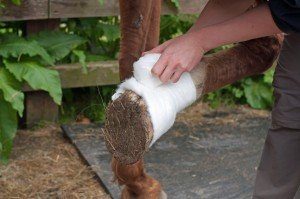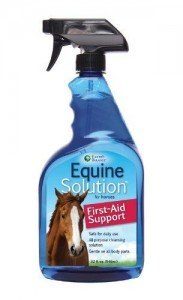If you’re a horse owner, you’re probably familiar with horse accidents. You might even have the veterinarian’s phone number memorized by now. More often than not, horses come in from the field, and they’ve punctured their leg on a protruding branch or scratched their face in a thorny bush. The best way to treat these injuries is to be prepared. In fact, having a first aid kit ready could be a matter of life and death. That’s why it’s a good idea to have a first-aid kit handy in more than one place, such as the barn, the trailer and on the trail.

A recent article in Equus magazine recommends having the following items:
Disinfectant for cleansing. Always wiping from the center of the wound out towards the surrounding skin. Consider an all-natural product like Equine Solution, a first aid support formula made with electrolyzed oxidizing water, which is the same effective ingredient that competitors use, but at a fraction of the cost. Electrolyzed oxidizing water can be used to treat rain rot, dryland distemper (pigeon fever), cinch fungus, ringworm, strangles, umbilical post, and post-surgical sites.
Antiseptic swabs and scrubs to clean wounds when you don’t have access to a water supply.
Wound powder/ointment to prevent new infection. Ointments have some water resistance, but are less easily absorbed than creams. Powders avoid the need to touch a wound, but are only absorbed by broken skin.
Antibiotic aerosol for the treatment of wounds to prevent infection without damaging tissue. Often colored (eg: blue or violet) to help with targeting. Take care to spray gently from the recommended distance.
Fly repellent to keep pests away from healing wounds.
Wound dressings to cover wounds without sticking to them and to promote healing.
Bandages, at least 3 to 4 inches wide and stretchy. Vet Rap is excellent for this as it sticks to itself and not to the horse. If you choose to use ordinary crepe bandages, they can be washed and re-used.
Insulating tape or safety pins for fastening the bandages.
Gamgee/field wrap, which is cotton wool sandwiched between two layers of gauze that comes in rolls. You can cut it to shape for padding beneath bandages, or use it as a pressure pad to stop bleeding. Available from your vet, or from an equine supply store. Padded leg wraps may be used, as long as they are well-fitting and do not bunch under the bandage and cause pressure points.
Cotton wool for cleaning wounds if no swabs are available, mopping up and dabbing on powders. Keep in mind that it’s not suitable for applying dry directly to wounds or for use as padding underneath bandages as it will stick to the wound. Take care to keep clean.

Epsom salts for soaking abscessed feet.
Scissors with rounded ends. Should be kept sharp for maximum efficiency.
Tweezers/forceps for removing splinters, etc.
Thermometer – the modern digital thermometers are easiest to read. A helpful hint is to attach a string and clip it to the horses tail so you don’t lose the thermometer.
Petroleum jelly to help insert the thermometer and protect soft tissues from soreness and chafing. Remember, all the preparation in the world doesn’t mean a thing if you don’t have access to it. First aid kits are only good if you have them when you need them. Have several, make sure they’re fully stocked. Having a first aid kit easily accessible during an emergency can pay off the investment many times over. It might even save your horse’s life.
